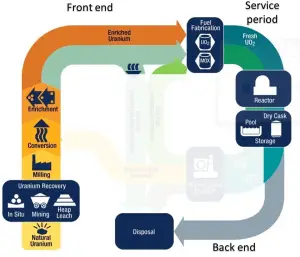
The nuclear fuel cycle is a process chain consisting of various stages. The nuclear fuel cycle starts with the mining of uranium and ends with the disposal of nuclear waste. The stages form a true cycle with the reprocessing of used fuel as an option for nuclear energy. In general, the nuclear fuel cycle consists of steps in the front end (the preparation of the fuel), steps in the service period (fuel burnup), and steps in the back end (reprocessing or disposal of spent nuclear fuel).
- The front end of the nuclear fuel cycle. The front end of the nuclear fuel cycle starts with the mining of uranium in the mines and ends with the delivery of the enriched uranium to the nuclear fuel assembly producer. Therefore, the front end of the fuel cycle consists of:
- Uranium mining, milling and mill tailings,
- Conversion
- Fuel enrichment
- Fabrication of fuel assemblies
- Service Period. The service period includes transport of fuel assemblies within a power plant, in-core fuel management, fuel utilization, and storage in the spent fuel pool.
- The back end of the nuclear fuel cycle. The back end of the nuclear fuel cycle involves managing the spent fuel after irradiation. Therefore, the back end of the fuel cycle consists of:
- spent interim fuel storage
- fuel reprocessing,
- final disposal of radioactive waste or spent fuel.
Open Fuel Cycle – Once-through Fuel Cycle

An open fuel cycle is not a real cycle, and this strategy assumes that the fuel is used once and sent to long-term storage without further reprocessing. If spent fuel is not reprocessed, the fuel cycle is referred to as an open fuel cycle or a once-through fuel cycle, as the uranium components go through the reactor once. The once-through cycle comprises two main back-end stages:
- interim storage
- final disposal.
In these cases, the fuel assemblies are first after irradiation, stored in spent fuel pools at the reactor site for an initial cooling period. Over time, as the spent fuel is stored in the pool, it becomes cooler as the radioactivity decays away. After several years (> 5 years), decay heat decreases under specified limits so that spent fuel may be interim storage. Interim storage can be either at the power plant site or at a centralized location that stores the fuel from more than one power plant. After a minimum period of 50 to 100 years of interim storage, spent nuclear fuel must be transferred to a final disposal facility. The preferred option is a deep geological repository, an underground emplacement in stable geological formations. The once-through cycle considers the spent nuclear fuel to be high-level waste (HLW) and, consequently, it is directly disposed of in a storage facility without being put through any chemical processes, where it will be safely stored for millions of years until its radiotoxicity reaches natural uranium levels or another safe reference level.
This strategy is favored by several countries: the United States, Canada, Sweden, Finland, Spain, and South Africa. Some countries, notably Finland, Sweden, and Canada, have designed repositories to permit future recovery of the material should the need arise. In contrast, others plan for permanent sequestration in a geological repository like the Yucca Mountain nuclear waste repository in the United States.
Types of Nuclear Fuel Cycles
As was written, the back end of the nuclear fuel cycle involves managing the spent fuel after irradiation. Therefore, the back end of the fuel cycle consists of:
- spent interim fuel storage
- fuel reprocessing,
- final disposal of radioactive waste or spent fuel.
There are three main types of nuclear fuel cycle:
- Once-through fuel cycle. An open fuel cycle is not a real cycle, and this strategy assumes that the fuel is used once and sent to long-term storage without further reprocessing. If spent fuel is not reprocessed, the fuel cycle is referred to as an open fuel cycle or a once-through fuel cycle, as the uranium components go through the reactor once. The once-through cycle comprises two main back-end stages:
- interim storage
- final disposal.
- Twice-through fuel cycle. The twice-through cycle strategy assumes that the spent nuclear fuel will be reprocessed to extract the uranium and plutonium, which can be recycled as fresh nuclear fuel for use in a nuclear reactor adapted to this type of fuel.
- Closed fuel cycle. The closed fuel cycle is an advanced fuel cycle whose purpose is to achieve nuclear power sustainability by further reducing the final waste’s radiotoxicity and improving resource utilization while maintaining its economic viability. There are currently different types of advanced fuel cycles under research, but most of them are based on the use of:
- Advanced Nuclear Reactors
- Fuel Reprocessing
These fuel strategies are based on specific processes in the entire fuel cycle (the back end, the front end, and the service period). All these scenarios are theoretical, and the practical solution will be, in any case, a combination of these options. In all cases, the fuel assemblies are first after irradiation, stored in spent fuel pools at the reactor site for an initial cooling period. It must be added that any strategy for managing spent nuclear fuel will be built around combinations of many options, and all strategies must ultimately include permanent geological disposal.
The choices of nuclear fuel cycle (open, closed, or partially closed through limited spent fuel recycling) depend upon the technologies we develop and societal weighting of goals (safety, economics, waste management, and nonproliferation). Once choices are made, they will have major and long-term impacts on nuclear power development. Today we do not have sufficient knowledge to make informed choices for the best cycles and associated technologies.
See more: The Future of the Nuclear Fuel Cycle. An interdisciplinary MIT study. MIT, 2011. ISBN 978-0-9828008-4-3.